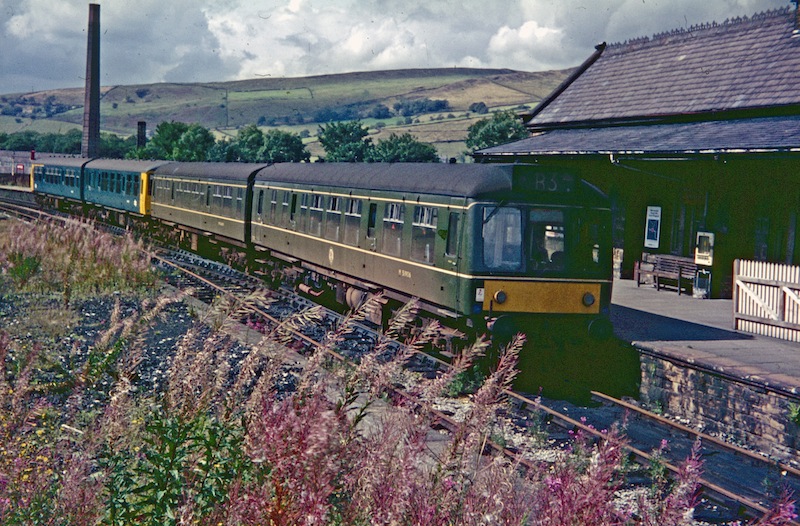Hayfield branch on:
[Wikipedia]
[Google]
[Amazon]



 The Hayfield Branch was a single-track branch line that ran along the Sett Valley from the Hope Valley Line near to , via one intermediate stop, . It passed under the town of New Mills through the rock-cut Hayfield tunnel.
The Hayfield Branch was a single-track branch line that ran along the Sett Valley from the Hope Valley Line near to , via one intermediate stop, . It passed under the town of New Mills through the rock-cut Hayfield tunnel.
 The branch opened, in 1868, to serve the villages along the valley of the River Sett and the local mills. It became the joint property of the Manchester, Sheffield & Lincolnshire Railway (later Great Central) and the
The branch opened, in 1868, to serve the villages along the valley of the River Sett and the local mills. It became the joint property of the Manchester, Sheffield & Lincolnshire Railway (later Great Central) and the
1947 timetable
* {{DEFAULTSORT:Hayfield Branch Closed railway lines in the East Midlands Rail transport in Derbyshire Railway lines opened in 1868



 The Hayfield Branch was a single-track branch line that ran along the Sett Valley from the Hope Valley Line near to , via one intermediate stop, . It passed under the town of New Mills through the rock-cut Hayfield tunnel.
The Hayfield Branch was a single-track branch line that ran along the Sett Valley from the Hope Valley Line near to , via one intermediate stop, . It passed under the town of New Mills through the rock-cut Hayfield tunnel.
History
Opening
 The branch opened, in 1868, to serve the villages along the valley of the River Sett and the local mills. It became the joint property of the Manchester, Sheffield & Lincolnshire Railway (later Great Central) and the
The branch opened, in 1868, to serve the villages along the valley of the River Sett and the local mills. It became the joint property of the Manchester, Sheffield & Lincolnshire Railway (later Great Central) and the Midland Railway
The Midland Railway (MR) was a railway company in the United Kingdom from 1844. The Midland was one of the largest railway companies in Britain in the early 20th century, and the largest employer in Derby, where it had its headquarters. It am ...
. It remained a joint station, latterly owned by the London and North Eastern Railway
The London and North Eastern Railway (LNER) was the second largest (after LMS) of the " Big Four" railway companies created by the Railways Act 1921 in Britain. It operated from 1 January 1923 until nationalisation on 1 January 1948. At th ...
and the London Midland Scottish Railway, until nationalisation of the railways in 1948. Passenger numbers were high especially in the summer months, as the line provided easy access to the countryside.
The branch was subsequently assigned to the London Midland Region of British Railways
The London Midland Region (LMR) was one of the six regions created on the formation of the nationalised British Railways (BR), and initially consisted of ex-London, Midland and Scottish Railway (LMS) lines in England, Wales and Northern Irela ...
. Introduction of diesel multiple unit (DMU) trains led to an improvement in passenger services and, by the 1960s, there was an hourly frequency to and from Manchester Piccadilly, with some additional trains at peak times. Unlike some neighbouring lines, the station also enjoyed an hourly Sunday service which was popular with walkers.
Kinder Reservoir
A short-lived continuation of the line was built in the early 20th century to convey materials and workmen during the construction ofKinder Reservoir
Kinder Reservoir is a public water storage reservoir on the western edge of Kinder Scout plateau in Derbyshire. The reservoir lies at the head of the Kinder Valley, above sea level and to the north east of the village of Hayfield. It is owned ...
.
Closure
AfterWorld War II
World War II or the Second World War, often abbreviated as WWII or WW2, was a world war that lasted from 1939 to 1945. It involved the vast majority of the world's countries—including all of the great powers—forming two opposin ...
, passenger traffic on the line reduced. The whole Manchester Piccadilly-Romiley-Hayfield line had been included in the 1963 Beeching cuts
The Beeching cuts (also Beeching Axe) was a plan to increase the efficiency of the nationalised British Rail, railway system in Great Britain. The plan was outlined in two reports: ''The Reshaping of British Railways'' (1963) and ''The Develop ...
proposals; however, the government chose instead to retain the Hope Valley line in favour of closing the Woodhead line to passenger services. The Hayfield line was closed in January 1970.
The site today
The line was purchased from British Rail byDerbyshire County Council
Derbyshire County Council is the upper-tier local authority for the non-metropolitan county of Derbyshire, England. It has 64 councillors representing 61 divisions, with three divisions having two members each. They are Glossop and Charlesworth, ...
in 1973 and now forms the Sett Valley Trail
The Sett Valley Trail is a Segregated cycle facilities, cycle- and Rights of way in England and Wales#Bridleways, bridleway in Derbyshire, England, linking the village of Hayfield, Derbyshire, Hayfield and the town of New Mills (via Birch Vale ...
.
References
External links
1947 timetable
* {{DEFAULTSORT:Hayfield Branch Closed railway lines in the East Midlands Rail transport in Derbyshire Railway lines opened in 1868